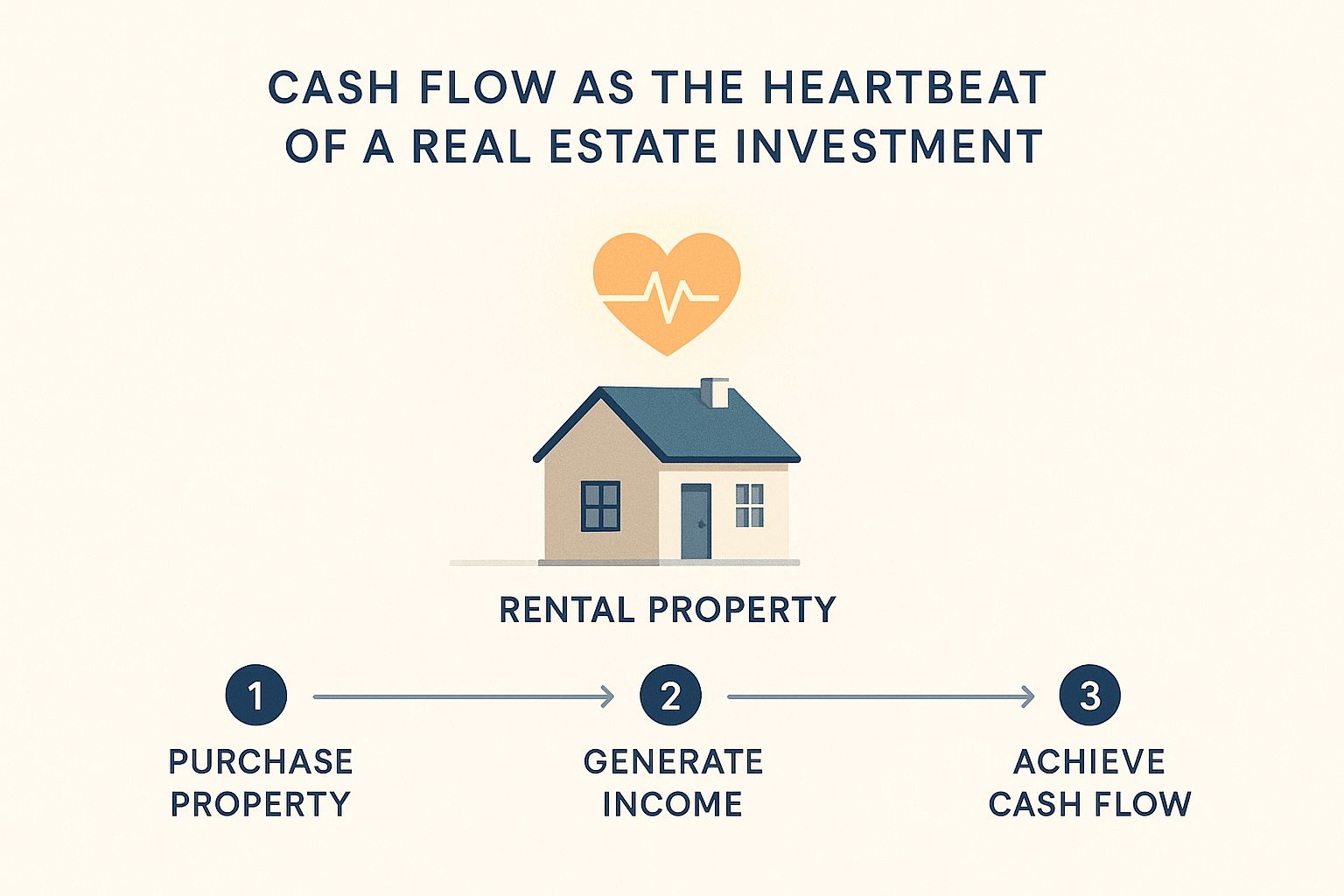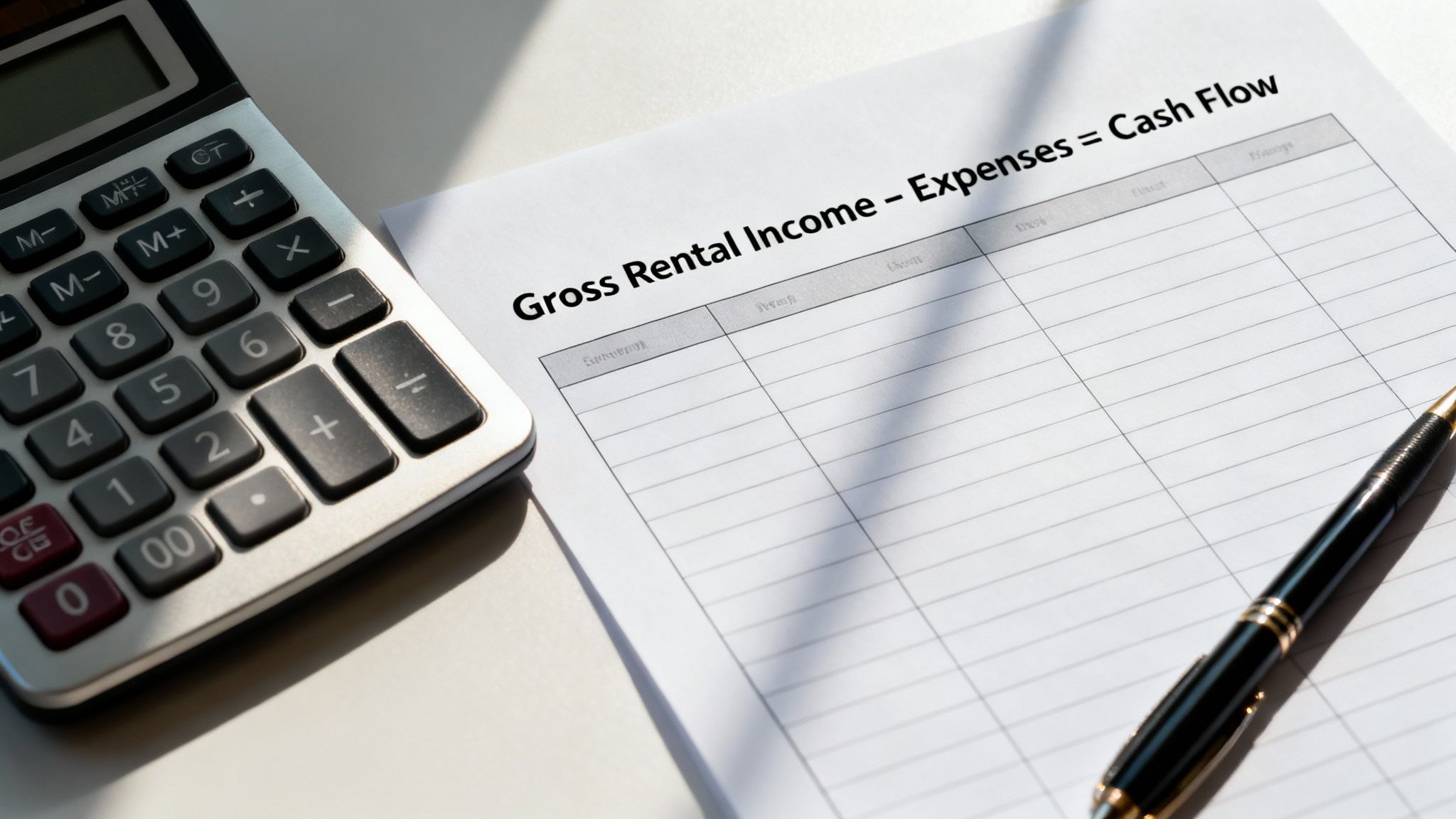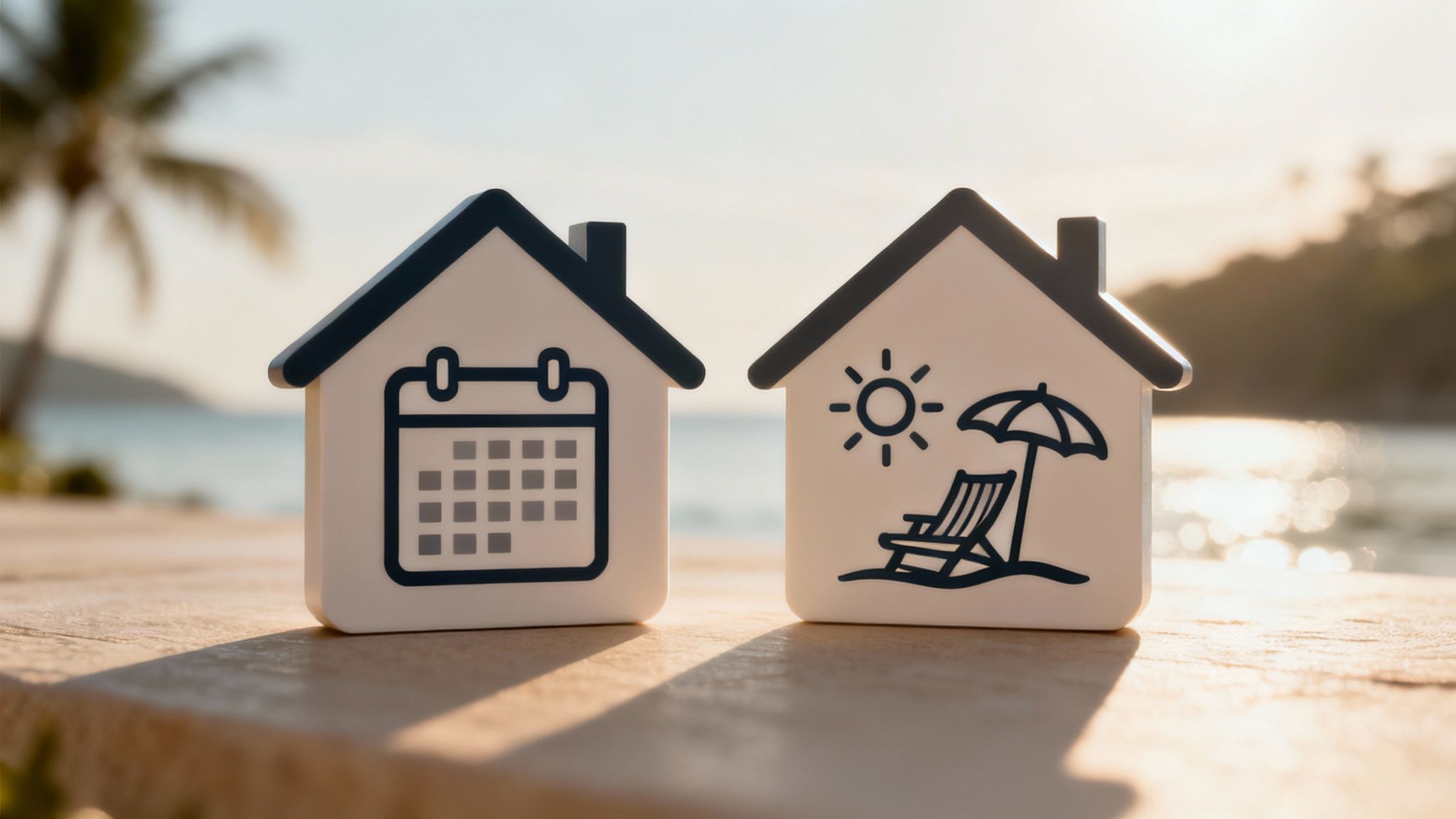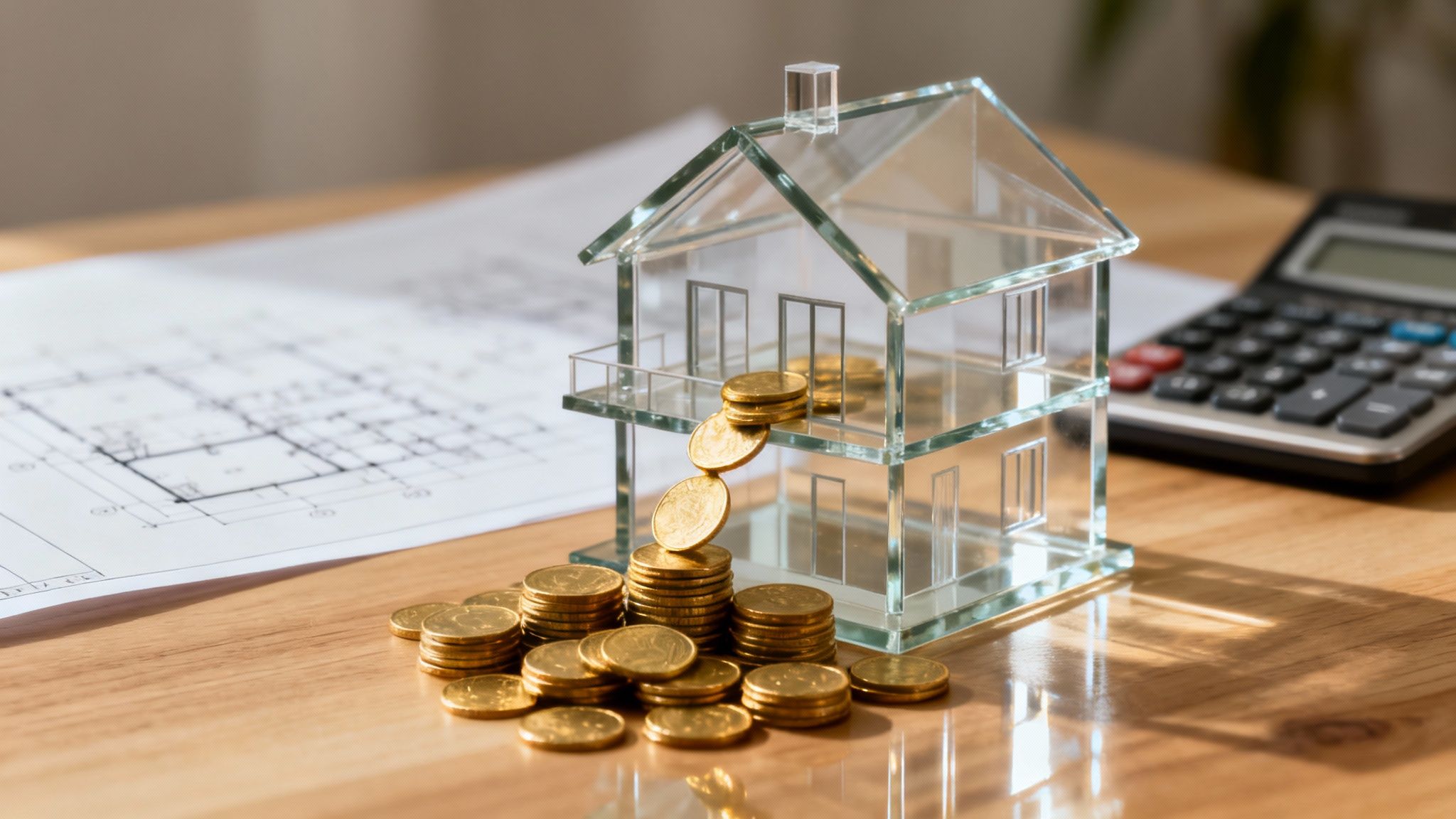In real estate, positive cash flow is the money left in your pocket after collecting rent and paying every single bill. It’s the monthly profit from your investment—the actual cash that hits your bank account. While appreciation is great, cash flow is the single most important metric for a healthy, sustainable rental property.
Why Cash Flow Is the Heartbeat of Your Investment
Many new investors fixate on appreciation, hoping their property’s value will skyrocket. While appreciation is a fantastic long-term bonus, relying on it alone is speculation, not investing. It's a gamble.
A much smarter strategy is to treat your investment like a small business. Your rent is the revenue. Your mortgage, taxes, insurance, and maintenance are the operating costs. Positive cash flow for real estate is your monthly profit, proving your business is healthy. Without it, you’re not running an investment; you're funding an expensive hobby.
This infographic nails the concept: cash flow is the lifeblood of your property, keeping it financially healthy.

When your income consistently exceeds your expenses, your investment doesn't just survive—it thrives. It’s like a healthy heart pumping life through the entire venture.
The Foundation of Financial Stability
Positive cash flow provides the financial cushion to handle the realities of being a landlord. It’s the money that covers unexpected headaches without you having to raid your personal savings. This stability is what turns a property from a source of stress into a genuine income-producing asset.
Here are the actionable benefits of a healthy cash flow:
- Covers Unexpected Repairs: When a water heater bursts or a storm damages the roof, positive cash flow means you have the funds on hand to fix it without panic.
- Manages Vacancies: Properties aren't occupied 100% of the time. The cash reserves you build from profitable months cover the mortgage and utilities when you're between tenants.
- Builds a Scalable Portfolio: Lenders want to see profitable properties. A documented history of positive cash flow makes it significantly easier to secure financing for your next investment.
Actionable Insight: Before you even make an offer, get a firm grip on your true net income. A great starting point is understanding the ins and outs of the UK Property Rental Income Tax Explained for Landlords. Knowing your tax obligations is essential for projecting your actual take-home earnings.
Success in real estate boils down to the numbers. To build confidence in evaluating deals, you must get comfortable with the calculations. Take the time to master the essential https://flipsmrt.com/blog/real-estate-math-formulas every investor must know. This groundwork allows you to analyze properties based on actual profitability, not just wishful thinking about appreciation.
Calculating Property Cash Flow Step by Step

Figuring out a property's cash flow isn't just for number-crunchers; it's the single most important skill any serious real estate investor needs to master. Forget guesswork. This is about knowing your numbers cold. The process is straightforward: start with all the money coming in, then subtract everything that goes out. What's left is your true profit.
Step 1: Start with Gross Rental Income
The first number you need is your Gross Rental Income (GRI). This is the absolute maximum rent you could collect if the property was occupied every single day of the year.
For instance, if you have a single-family home renting for $2,000 per month, your annual GRI is:
$2,000/month x 12 months = $24,000
This is your starting line. From here, we account for the realities of being a landlord.
Step 2: Identify and Subtract All Operating Expenses
Operating expenses are all the costs of keeping the property running—everything except your mortgage payment. Smart investors are brutally honest about these numbers.
Actionable Tip: Don't rely on the seller's expense sheet. Do your own due diligence. Call local insurance agents for quotes, look up property tax records online, and get estimates from property managers.
Here are the key expenses to factor in:
- Vacancy Allowance: No property stays rented 100% of the time. A conservative estimate of 5% to 8% of your GRI is a safe bet to cover those empty months.
- Property Taxes: Your annual bill from the city or county. This is a non-negotiable expense.
- Insurance: Your landlord or hazard insurance policy.
- Property Management Fees: If you hire a pro, expect to pay 8% to 10% of the collected rent. Even if you self-manage, it's wise to budget for this in case you scale up later.
- Repairs and Maintenance: Budget for small stuff—a leaky faucet, a broken doorknob. A good rule of thumb is 5% to 10% of GRI.
- Capital Expenditures (CapEx): This is the big one rookies forget. You need a separate savings account for major replacements like a new roof, HVAC system, or water heater. Budgeting another 5% to 10% of GRI is crucial for long-term success.
Subtracting these operating expenses from your Gross Rental Income gives you your Net Operating Income (NOI). NOI is a critical metric because it shows you how profitable the asset itself is, completely separate from your financing.
Step 3: Calculate Your Final Cash Flow
The last piece of the puzzle is your financing, or debt service. This is your total annual mortgage payment (principal and interest). Subtract your annual debt service from your NOI, and you’ll have your pre-tax cash flow.
Sample Cash Flow Calculation for a Rental Property
Here’s a breakdown for our hypothetical rental property, showing how each line item affects the final number.
| Item | Monthly Amount | Calculation Notes |
|---|---|---|
| Gross Rental Income | $2,000 | The maximum potential rent. |
| Vacancy (5%) | -$100 | Budgeting for one month vacant every 20 months. |
| Property Taxes | -$150 | Estimated based on local millage rates. |
| Insurance | -$75 | Standard landlord policy cost. |
| Repairs & Maintenance (5%) | -$100 | Earmarked for routine upkeep. |
| Capital Expenditures (5%) | -$100 | Savings for major future replacements. |
| Net Operating Income | $1,475 | Income after all operating costs are paid. |
| Mortgage Payment (P&I) | -$1,100 | The cost of financing the property. |
| Net Cash Flow | $375 | The final profit in your pocket each month. |
This detailed process removes emotion and helps you make decisions based on hard data. For a more detailed walkthrough, learn exactly how to calculate cash flow on a rental property in our complete guide. Once you master this calculation, you can confidently analyze any potential investment.
The Real-World Forces That Shape Your Cash Flow
A spreadsheet only tells part of the story. The profitability of a property is constantly influenced by powerful real-world forces. Winning investors understand these forces and learn how to manage them.
Location, Location, Location—It's Not a Cliché
The neighborhood you buy in dictates your tenant pool, maximum rent, and long-term appreciation.
Actionable Insight: Before buying, drive the neighborhood on a Tuesday morning and a Saturday night. Are lawns mowed? Are cars in good repair? Talk to local property managers and ask them which areas attract long-term, reliable tenants and which ones they avoid. A property near a booming university or corporate headquarters has built-in demand, supporting consistent occupancy and giving you leverage to raise rents over time. A strong location is your safety net.
Property Condition and Your Budget
The physical state of your property is a direct lever on your monthly expenses. An older building with a tired roof or a wheezing HVAC system isn't just a property—it's a financial time bomb.
A property's condition is a direct preview of your future maintenance budget. A well-kept property means proactive, predictable spending. A neglected one guarantees reactive, budget-destroying emergencies that can vaporize your cash flow.
Actionable Insight: Always get a professional home inspection. Use the inspector's report to create a 5-year CapEx budget. If the roof has 3 years of life left, start saving for its replacement now, not when it starts leaking. This turns a future crisis into a manageable line item.
Financing Terms and the Economic Big Picture
For most investors, the mortgage is the single biggest expense. The terms you lock in are critical. A slightly lower interest rate or a longer amortization period can dramatically cut your monthly payment, giving your cash flow an immediate boost.
You also have to pay attention to what's happening in the local economy.
Actionable Insight: Look for cities with diverse job markets. A town reliant on a single factory is fragile. A city with healthcare, tech, and education sectors is more resilient. Follow local news about major employers moving in or out. These economic trends directly impact your ability to find tenants and raise rents.
Comparing Investment Strategies for Maximum Cash Flow

Not all real estate investments are created equal, and your chosen path will have a massive impact on your cash flow for real estate. Aligning your strategy with your financial goals, risk tolerance, and desired level of involvement is key. The market itself is always in motion; real estate deal value recently jumped 11 percent to $707 billion, largely driven by strong financing conditions and high demand in sectors like multifamily. You can get more insights on these private market trends over at McKinson.com.
Traditional Long-Term Rentals
This strategy—a single-family home, duplex, or small apartment building—is the bedrock of many successful portfolios because of its predictability. You sign a lease for a set period, usually a year, creating a steady stream of income.
- Steady Income: Rent payments are consistent, making it easier to forecast cash flow.
- Lower Turnover: Year-long leases mean less time and money spent finding new tenants.
- Simpler Management: Day-to-day involvement is less intense than with short-term rentals.
- Lower Gross Revenue: The trade-off for stability is a lower ceiling on your income.
Actionable Takeaway: This is ideal for investors seeking a more hands-off approach with predictable returns. It's a solid foundation for building wealth through consistent cash flow and long-term appreciation.
Short-Term Vacation Rentals
Platforms like Airbnb and Vrbo have made short-term rentals incredibly popular. These properties can generate significantly more gross revenue but come with higher costs and operational demands. This is an active business, not a passive investment.
- Higher Revenue Potential: You can charge premium nightly rates, especially during peak seasons.
- Intensive Management: This is the opposite of passive. You're responsible for constant cleaning, guest communication, and booking management.
- Variable Income: Income can swing wildly based on seasonality, new regulations, and competition.
- Higher Expenses: Expect higher bills for utilities, cleaning, platform commissions (typically 3-5%), and fully furnishing the property.
Actionable Takeaway: Before buying a short-term rental, use a tool like AirDNA to analyze the occupancy rates, average nightly rates, and seasonality of the specific neighborhood. Don't rely on guesswork.
Commercial Properties
Commercial real estate—office buildings, retail spaces, or industrial warehouses—is a different game. Leases are much longer (three to ten years) and often structured as a "triple net" (NNN) lease, where the tenant pays for property taxes, insurance, and maintenance. This can create a highly passive income stream. However, the barrier to entry is significantly higher, requiring more capital and specialized knowledge.
Actionable Strategies to Increase Your Cash Flow
Improving your property’s profitability isn’t passive. It’s about making smart, deliberate moves that either boost income or cut expenses. Successful investors attack both sides of the equation.Smart Ways to Increase Your Income
Growing your revenue doesn't always require a major overhaul. Small, strategic adjustments can lead to a big jump in monthly income.
- Perform a Market Analysis to Justify Rent Increases: Use platforms like Rentometer or Zillow Rental Manager to check comparable rents in your area every six months. If your property is well-maintained and you're below market rate, a modest, justified rent increase is just good business.
- Add High-ROI Amenities: Some upgrades practically pay for themselves. Installing an in-unit washer and dryer can command a rent premium of $50-$100 per month. Adding smart-home features like a Nest thermostat or a keyless entry lock can also attract higher-paying tenants.
- Create Ancillary Revenue Streams: Think beyond the rent check. You could charge a monthly fee for premium covered parking spots, offer secure storage units in an unused basement area, or install a coin-operated laundry facility in a multifamily building.
Actionable Takeaway: Don't let income stagnate. Survey your tenants annually. Ask them what amenities they would be willing to pay a little extra for. Their answers are a direct roadmap to increasing your revenue.
Intelligent Methods for Reducing Expenses
Every dollar you save on operating costs drops directly to your bottom line. This requires a forward-thinking, vigilant approach.
- Implement Preventative Maintenance: Create a checklist. Schedule an HVAC tune-up every spring and fall. Clean gutters twice a year. Snake main drains annually. This proactive approach prevents small issues from becoming budget-destroying catastrophes.
- Shop Your Insurance Annually: Don't let your policy auto-renew. One month before renewal, get fresh quotes from at least three different providers. You may find you're overpaying for the same coverage.
- Appeal Your Property Taxes: Review your property tax assessment each year. If you believe the assessed value is higher than its true market worth (perhaps due to a recent downturn or incorrect property details), filing an appeal could lead to a significant drop in your annual tax bill.
Exploring the best property management apps can be a game-changer. These tools help automate rent collection and track maintenance, plugging leaks in your expense budget. For a deeper dive, check out our complete guide to maximizing your rental property cash flow.
Common Questions About Real Estate Cash Flow
Even after you learn the formulas, questions pop up when analyzing deals in the real world. Let's clear up the most common ones.
What Is a Good Monthly Cash Flow Number?
While there's no universal magic number, the $100 per door rule is a classic benchmark. This guideline suggests that after all expenses, a property should net at least $100 per month for every unit. For a single-family rental, that’s $100/month. For a duplex, you'd aim for $200/month.
Actionable Takeaway: The $100 rule is a quick filter, not a hard-and-fast law. An investor in a high-appreciation market like Austin might accept lower cash flow. An investor in a stable Midwest market might demand much more. Your personal goals dictate what "good" means for you.
How Do You Estimate Future Repair Costs?
Budgeting for repairs and big-ticket replacements (Capital Expenditures or CapEx) separates the pros from the amateurs. Use a system, not a guess.
- The 1% Rule: Budget 1% of the property's purchase price for annual maintenance. On a $250,000 house, set aside $2,500 per year (about $208 per month). This is best for newer or recently renovated properties.
- The 50% Rule: This gut check assumes roughly 50% of your gross rent will go to all operating expenses—not including your mortgage. It forces you to account for taxes, insurance, management, vacancy, and repairs.
Actionable Takeaway: For a more precise estimate, create a "component list." Itemize the major systems (roof, HVAC, water heater) and estimate their remaining useful life. Divide the replacement cost by the number of years left to determine how much you should save monthly for each item.
What Is the Difference Between Cash Flow and Cash-on-Cash Return?
These two metrics are easily confused, but you need both to get a complete picture.
Cash Flow is the raw dollar amount left over each month or year. Our earlier example of $375 per month is the cash flow.
Cash-on-Cash (CoC) Return measures how hard your invested money is working for you. It’s a percentage showing the return on the actual cash you paid for the down payment, closing costs, and initial rehab.
The formula is:Annual Cash Flow / Total Cash Invested = Cash-on-Cash Return
If you invested $50,000 to generate an annual cash flow of $4,500 ($375 x 12), your CoC return would be 9%. This metric is crucial for comparing different investment opportunities and deciding where to deploy your capital for the best results.
Stop wasting hours on spreadsheets and start making smarter investment decisions in seconds. Flip Smart gives you the power to analyze any property's valuation, renovation costs, and profit potential instantly. Get the data-driven clarity you need to find your next winning deal.
Discover how to analyze properties faster at https://flipsmrt.com.
